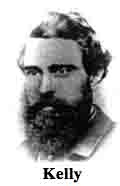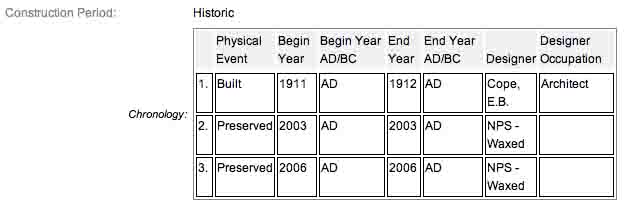
he 2nd Corps, 1st Division, 2nd Brigade was also known as Kelly’s Irish Brigade. During the battle of Gettysburg, it served as a member of Caldwell’s Division in the Second Corps, Army of the Potomac. The brigade was commanded by Colonel Patrick Kelly (ca. 1822 – June 14, 1864), an Irish-American Union Army officer during the American Civil War. He led the famed Irish Brigade at the Battle of Gettysburg. Kelly was born in Castlehacket, Tuam, County Galway, Ireland, and emigrated to the United States, landing in New York City. At the age of 42, Kelly died during the Siege of Petersburg when he was shot though the head while leading the Irish Brigade forward against Confederate earthworks. His body was recovered and sent back to New York for his funeral. He was buried in First Calvary Cemetery in Woodside, New York.
The Tilton's Brigade - US Brigade Tablet is located Sickles Avenue, on the right or east side when traveling north. The monument is located at the end of a tight loop in the road, called, fittingly enough, the Loop.  Parking is available at intermittently enlarged shoulder cutouts on the right side of the road, but certainly not at the loop so exercise common sense. Be sure to keep vehicles off the grass or you will be ticketed by park police. I visited this monument on Thursday, July 5, 2012 at 2:42 P.M. I was at an elevation of 555 feet, ASL. I used a Canon PowerShot 14.1 Megapixel, SX210 IS digital camera for the photos.
Parking is available at intermittently enlarged shoulder cutouts on the right side of the road, but certainly not at the loop so exercise common sense. Be sure to keep vehicles off the grass or you will be ticketed by park police. I visited this monument on Thursday, July 5, 2012 at 2:42 P.M. I was at an elevation of 555 feet, ASL. I used a Canon PowerShot 14.1 Megapixel, SX210 IS digital camera for the photos.
The monument work was done under the direction of the Gettysburg National Park Commission (established by the United States Department of War), after they took over the administration of the park from the Gettysburg Battlefield Memorial Association (whose funds had expired) on March 3, 1893, and whose stewardship was then transferred to the National Park Service in 1933) SOURCE. According to the NRHP narrative, this monument was built in 1911 but finished in 1912, which according to my experience is questionable. I can't resolve if the 1912 date represents a completion of the physical construction of the tablet or an installation date. Other sources have it at 1910 & 1912. I don't know if anyone actually kept exact records of when these things were installed.
Draw the Sword, with descriptive help from the NPS site, offers the following description: Monolith consisting of polished smooth sea-green granite pedestal with a square base. Base tapers to a smaller dimension at the tablet. On each pedestal is mounted a bronze inscription tablet describing the movements and actions of the unit. The Maltese Cross symbol of the Fifth Corps appears at the top of the tablet.
One of 74 (or 75 depending who you listen to) Union brigade monuments erected at Gettysburg by the United States War Department to describe the movements and itinerary of each Union brigade of the Army of the Potomac. The monuments were designed by E.B. Cope. Many of the inscription tablets were made of bronze melted down from Civil War cannons. The inscription on this tablet reads:
 Army of the Potomac
Army of the Potomac
Second Corps First Division
Second Brigade
Col. Patrick Kelly
28th. Massachusetts
63d. (2 Cos.) 69th. (2 Cos.) 88th. (2 Cos.) New York
116th. (4 Cos.) Pennsylvania Infantry
July 2 Arrived at 7 a.m. and took position on line from Cemetery Hill to Round Top at the right of First Brigade. Between 5 and 6 p.m. went with Division to left. First Brigade on the left Third Brigade on right. Engaged the Confederate forces including Brig. Gen. Anderson's Brigade Major Gen. Hood's Division in the Wheatfield and forced them through the field southerly into woods beyond capturing many prisoners. The Fourth Brigade having advanced on the left this Brigade held its position until the Division being flanked on right and left retired and resumed former position in line of the Corps.
July 3 Constructed breastworks and remained entrenched until the close of the battle.
Casualties. Killed 1 officer 26 men. Wounded 4 officers 105 men. Captured or missing 2 officers 60 men. Total 198.
There are hundreds of non-sculpted monumentation for the various Confederate States & Union units which fought at Gettysburg. There are about 10 different variations of tablets, markers & monoliths by my reckoning. Six designs represent brigade (2), division (2), corps (2), & army headquarters (2), each different in a subtle way so as to distinguish between armies. Battalion/battery/advance position markers & regimental monuments for U.S. Regulars & Confederate have their own distinct design (2), bringing the total to 10 designs at the battlefield. The bronze tablets were created by Albert Russell & Sons Co. of Newburyport, Mass. The granite bases which accompany the various tablets were created by the Van Amringe Company from Boston, Mass. The cast iron tablets were manufactured by Calvin Gilbert. The 1910 Gettysburg Commission report lists the awarded contracts to these companies (not Gilbert) for the tablets. All of these tablets were designed by architect Colonel Emmor Bradley Cope (July 23, 1834 - May 28, 1927). He designed pretty much every tablet for both the Union & Rebel armies, each one distinct, w/ several different varieties. He is buried in Evergreen Cemetery  in Gettysburg, as well he should be as this park and most of the things seen here today were designed by him and as such, are his legacy. These monuments were erected just after the turn of the century during the first & beginning of the second decade of the 20th century. Each one has since been preserved or restored at least twice since the turn of the 21st century. The plaques & tablets were erected by the Gettysburg Park Commission (established by the War Dept.). The Gettysburg Park Commission is also referred to as the Gettysburg National Military Park Commission or the Gettysburg National Park Commission, to clear up any confusions, especially my own.
in Gettysburg, as well he should be as this park and most of the things seen here today were designed by him and as such, are his legacy. These monuments were erected just after the turn of the century during the first & beginning of the second decade of the 20th century. Each one has since been preserved or restored at least twice since the turn of the 21st century. The plaques & tablets were erected by the Gettysburg Park Commission (established by the War Dept.). The Gettysburg Park Commission is also referred to as the Gettysburg National Military Park Commission or the Gettysburg National Park Commission, to clear up any confusions, especially my own.
On October 1, 1898, the Gettysburg National Park Commission in a letter to the Secretary of War set gave recommendations for continuing the task of organizing & progressing the work of the Gettysburg National Military Park. Every November they wrote their annual report which outlined the work of the GNPC for that year. The following is an excerpt from that report relevant to this waymark. The link at the end of the paragraph will take you to the entire report. The method of marking the positions of troops on this field, as approved by the War Department, is to place the principal tablet or monument of each command at the position occupied by the command in the main line of battle, and to mark the several important positions subsequently reached by each command in the course of the battle by subordinate and ancillary tablets, with appropriate brief inscriptions giving interesting details and occurrences and noting the day and hour as nearly as possible. SOURCE
Most of the Commission reports have been digitized and can be found HERE. The initial 1893 report up to & including 1921 can be found here. 1922 to 1926 are missing & have yet to be discovered. The years 1927 to 1933 were discovered in 1996 and are also included. To my knowledge this is the most comprehensive list of documents that illustrated the development and formation of the park.
Information about these specific types of monuments:
BRIGADE HEADQUARTERS MARKERS (FOR UNION & CONFEDERATE TABLETS)
Brigade Headquarters (and Confederate artillery battalions, equivalent to Union artillery brigades) are bronze tablets mounted at an angle on a stone pedestal. They are the most numerous headquarters at Gettysburg, with over 70 Union and over 60 Confederate examples on the field. Union headquarters are marked with their corps or service branch symbol (like a cross, clover or crescent moon), while Confederate headquarters are simply labeled "C.S.A.". There are seventy-four brigade markers at Gettysburg honoring the AOP’s various brigades. (Other sources say there are 75). They were built by Albert Russell & Sons Co. of Newburyport, Massachusetts and Charles Kappes. The pedestals consist of sea-green granite with a square 36” x 36” base; they weigh 3500 pounds. On each pedestal is mounted a bronze tablet with rounded corners weighing 300 pounds. There are sixty-four brigade markers honoring the Army of North Virginia's various brigades. They were built by Van Amringe Granite Company (pedestals), Albert Russell & Sons Co., Newburyport, Mass (tablets) and Charles Kappes (foundations). The last was completed in December 1910. The 1910 date is disputed by other sites listing the end dates as 1912. The monuments consist of red circular Maine granite bases 34 1/2 inches diameter and weighing 3,000 pounds. On each base is mounted a 300 pound bronze tablet. SOURCE & SOURCE
The Kelly's Brigade - US Brigade Tablet is a contributing feature to the Gettysburg Nat'l Military Park H.D. which is nationally significant under NR Criteria A, B, C & D. Areas of Significance: Military, Politics/Gov't, Landscape Architecture, Conservation, Archeology-Historic. Period of Significance: 1863-1938. The monument is designated as structure no. MN471.
From the Nomination Form:
1 of 75 Civil War US Brigade Tablets in Park. Records movement & itinerary of Kelly's 2nd Brigade during Battle of Gettysburg, July 1-3, 1863.
Short Physical Description:
Bronze inscription tablet, 4”0’ x 3’8”, attached to slant face of polished sea green granite monolith. 3’0” squared base of monument tapers to a smaller dimension at the tablet. All 5’4” H.
Long Physical Description:
Located on Sickels Avenue, near the Loop.

My Sources
1. NRHP Nomination Form
2. Stone Sentinels
3. Virtual Gettysburg
4. Draw the Sword
5. Historical Marker Database
6. Wikipedia